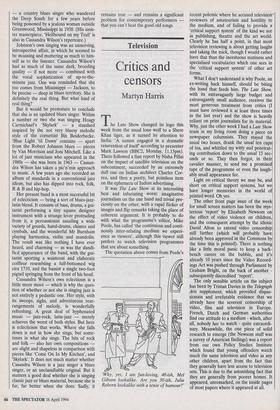Television
Critics and censors
Martyn Harris
The Late Show changed its logo this week from the usual lone wolf to a Shere Khan tiger, as it turned its attention to India: 'A nation engaged in a dramatic reinvention of itself' according to presenter Mark Lawson (BBC2, Monday, 11.15pm). There followed a fine report by Nisha Pillai on the impact of satellite television on the subcontinent, succeeded by an extremely dull one on Indian architect Charles Cor- rea, and then a pretty, but pointless item on the ephemera of Indian advertising.
It was The Late Show at its interesting best and infuriating worst: imaginative journalism on the one hand and trivial pre- ciosity on the other, with a rapid flicker of images and flip remarks taking the place of coherent argument. It is probably to do with what the programme's editor, Mike Poole, has called 'the continuous and conti- nously inter-relating medium we experi- ence as viewers', although this viewer still prefers to watch television programmes that are about something.
The quotation above comes from Poole's `Why, yes, I am fun-loving, 40-ish, Mel Gibson lookalike. Are you 30-ish, Julia Roberts lookalike with a sense of humour?' recent polemic where he accused television' reviewers of amateurism and hostility to the medium, and of failing to provide a `critical support system' of the kind we see in publishing, theatre and the art world.
Clearly he has half a point, in that most television reviewing is about getting laughs and taking the mick, though I would rather have that than the incestuous matiness and specialised vocabularies which one sees in the 'critical support system' of other art forms.
What I don't understand is why Poole, an ex-writing hack himself, should be biting the hand that feeds him. The Late Show, with its extravagantly large budget and extravagantly small audience, receives the most generous treatment from critics (I must have reviewed it at least three times in the last year) and the show is heavily reliant on print journalists for its material.
Why, just the other week I had a Late Show team in my living room doing a piece on newspaper columnists. They stayed the usual two hours, drank the usual ten cups of tea, and whittled my witty and penetrat- ing contribution down to the usual 15 sec- onds or so. They then forgot, in their cavalier manner, to send me a promised tape of the programme or even the laugh- ably small appearance fee.
Light on critical theory we may be, and short on critical support systems, but we have longer memories in the world of printed word. Oh yes.
The other front page issue of the week for small screen matters has been the mys- terious 'report' by Elizabeth Newsom on the effect of video violence on children, and the consequent attempt by the idiotic David Alton to extend video censorship still further (which will probably have already been approved in the Commons by the time this is printed). There is nothing like a little moral panic to keep a back- bench career on the bubble, and it's already 10 years since the Video Record- ings Act was pushed through Parliament by Graham Bright, on the back of another subsequently discredited 'report'.
The only sensible article on the subject has been by Tristan Davies in the Telegraph Arts supplement, which provided dispas- sionate and irrefutable evidence that we already have the severest censorship of video, film and television in Europe.
French, Dutch and German authorities find our attitude to a medium - which, after all, nobody has to watch - quite extraordi- nary. Meanwhile, the one piece of solid research to emerge (the Newsom stuff was a survey of American findings) was a report from our own Policy Studies Institute which found that young offenders watch much the same television and video as any other children, apart from the fact that they generally have less access to television sets. This is due to the astonishing fact that they are generally from poorer homes. It appeared, unremarked, on the inside pages of most papers where it appeared at all.


























































 Previous page
Previous page